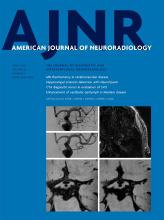We greatly appreciate the interest of Dr Kim in our work and his knowledgeable comments regarding our article that was recently published in the American Journal of Neuroradiology.1 He has highlighted several important points that we will address in this response.
The first implication on the meaning of the asymmetry of the cell cluster, regardless of whether nigrosome-1 is healthy, is important and should be clarified. Our study discussed the visualization of nigrosome-1 asymmetry using clinical MR imaging.2 We believe that our views are shared by most authors with considerable experience in clinical MR imaging examinations.
Dr Kim suggests that the magic angle effect appears hyperintense because of sequences using a short TE. It is rightfully pointed out that this is an MR imaging phenomenon that is often discussed with regard to fiber structures in orthopedic and neurologic cases, among others. However, we discuss the magic angle that presents universally in the B0 direction. In particular, the change in the magnitude of the interaction becomes a conspicuous interference along the magic angle because of the dipole–dipole interaction.3,4 This change affects the MR signal intensity around the boundary between the susceptibility of different tissues. As mentioned earlier in the Discussion section, quantitative susceptibility mapping was performed to support the magic angle. Our response to the third question is the same as previously mentioned. It is not the relation to the fiber array dependency.
Fig 5A reveals the quantitative susceptibility mapping, which was not used to describe the nigrosome-1 regions. Quantitative susceptibility mapping eliminates the magic angle effect because of the deconvolution of phase data with a dipole kernel. The imaging techniques that make nigrosome-1 hyperintense (ie, the swallow tail sign) affect the magic angle; therefore, there are differences in image contrasts.
Finally, the volume of nigrosome-1 is 7 slices’ worth that was reported in a previous study by Dr Kim (ie, 0.5 × 0.5 × 1.0 mm3).5 The partial volume effect cannot be assumed because our voxel size parameter (ie, 0.63 × 0.63 × 1.5 mm3) wasslightly larger than that reported by Dr Kim. To be sure, we performed high-resolution (ie, 0.5 × 0.5 × 0.9 mm3) imaging (Figure). As indicated, the same result was obtained in Fig 4 of our article, hence, proving that there was no partial volume effect.
Examples of nigrosome-1 visualization in the B0 direction using high resolution (ie, 0.5 × 0.5 × 0.9 mm3), with a right head tilt (A), without a head tilt (B), and with a left head tilt (C).
References
- © 2020 by American Journal of Neuroradiology













